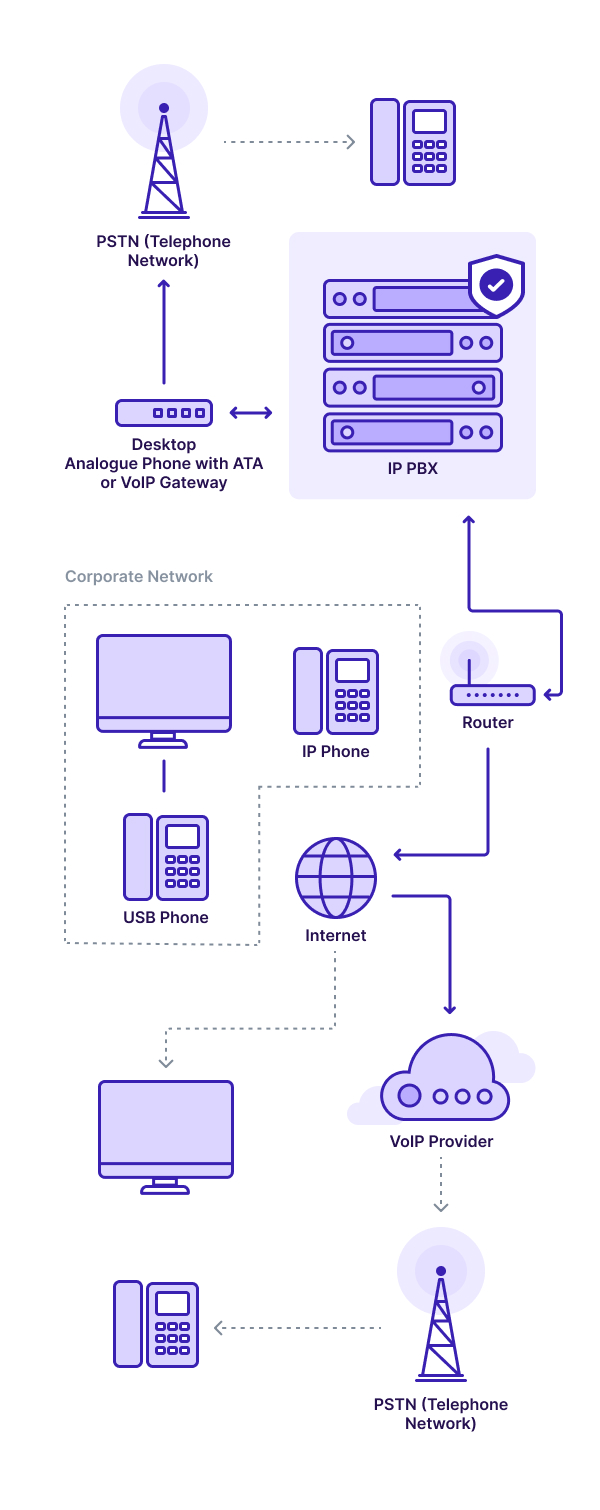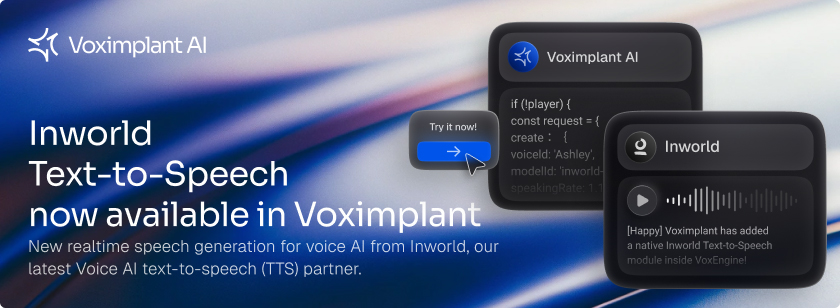As your company grows from a start-up to a thriving organization, you will want to ensure your staff can connect with each other, your business partners, and customers with ease. Those in search of looking for better business connectivity often find themselves looking into Private Branch Exchange (PBX) systems.
The main premise behind a PBX system is the convenience of maintaining one main number with extensions for each employee. Rather than giving each staff member a dedicated phone line, you will streamline them all into one. Not only does this spare you multiple phone bills, but it also provides a number of other business benefits as well.
Sizes and the complexity of PBX systems vary, ranging from simple systems designed with basic features to multi-layered corporate communications systems with much more extensive functionality. In this guide, we’ll explore what gives PBX systems a distinct advantage over traditional phone lines.
Vocabulary
If you are new to business communication solutions and associated technology, it can feel like you've stumbled into a conversation where everyone is speaking a different language. Below are a couple of terms that are essential to the topic at hand.
PBX
PBX, or Private Branch Exchange, is a phone system that consolidates multiple phone lines into one and routes calls within an organization. Phones don’t need to be connected directly to the line – instead, the PBX system assigns them.
PBX phone systems support internal communication (within the company) as well as external (with customers, partners, etc.) through different channels – Voice over Internet Protocol (VoIP), Integrated Services Digital Network (ISDN), or analog.
This technology has replaced live switchboard operators who would physically wire a connection to the appropriate extension when somebody called an office. Essentially, PBX automates this task.
PBX Server
The PBX server is the brain of the system. Whenever the system receives or makes a call, the server regulates where the call should go. There are PBX servers meant for traditional systems running on phone lines and for systems operating over the Internet.
The output is essentially the same for both – the server determines the appropriate channel for users to get connected. The difference is what they use to establish that connection.
PBX Hardware
Depending on the type of PBX system, it will have different hardware set up. It can consist of the telephone units, cables, and the switchboard itself, which is often housed in a cabinet; alternatively, other types of PBX systems run on computer servers, which make them more compact.
PBX Phone System Features
When you’re looking for the best PBX phone systems, you can expect the following functionality:
- Extension dialing – An entire office can use the same number, but different employees/departments will be assigned unique extensions, which eliminates the confusion associated with multiple numbers within the same company.
- Call transfer – The call can be transferred to a different extension without dropping the call. The first one will then be available to answer other calls.
Business hour settings – Depending on the schedule you set, PBX phone solutions will route calls during off-hours. This enables connectivity with branches that use an after-hours or 24/7 customer support line. - Caller queuing – Even though callers don’t enjoy being put on hold, they do appreciate being told how long their expected wait time is. Plus, caller queuing can be based on certain parameters and you can prioritize some callers over others.
- Call conferencing – PBX phone systems help businesses arrange conference calls with ease. Since you don't have to hold face-to-face meetings regularly, you can reduce costs with virtual meetings.
- Voicemail-to-email – An Internet-enabled PBX phone system lets you listen to your voicemail messages from your computer, email inbox, or mobile device. This reduces the possibility of missing an important voicemail when you don’t have your phone with you.
- Call recording and detailed phone records – This feature is used to keep track of conversations, or for those who would like to keep track of who is calling and why. Archived calls, for example, serve as an important element in litigation proceedings.
Types of PBX Systems Available Today
PBXs are presented in several varieties, although these days, most of the solutions are digital and leverage the Internet to send and receive calls as well as other communication features. Below is a quick run-down of the common types of PBX systems used today.
We will start by taking a look at the oldest PBX even though it is not a suitable choice for modern-day businesses.
Traditional Analog PBX Phone System
These telephone systems have been around for several decades. They use Plain Old Telephone Service (POTS) lines to connect to the Public Switch Telephone Network (PSTN), the original telephone service.
Incoming calls are physically routed to the PBX and then to other phones over copper wiring. The hardware of the analog PBX is quite bulky and sits in an office's telecom closet. This technology predates the Internet and does not support most of the features essential for offices today.
On-Premise IP PBX
This type is vaguely similar to the traditional PBX since it also resides at a physical location;however, on-premise IP PBX uses a more evolved piece of technology. IP phones connect to the IP-PBX server via the local area network (LAN).
Calls are placed using a traditional phone company or VoIP using SIP trunking. The service might already be offered by your provider, but a SIP trunk can be configured for use with an Internet Service Telephone Provider (ISTP).
Cloud Phone System
A cloud PBX can be accessed from any Internet-enabled device that supports the interface software. If you have an account, you will need to log in with a password or security question to start using it. The system can have several means of access at once, meaning users aren’t tied to any specific location.
Unlike the other two types, the responsibility of data storage and management falls on cloud PBX providers. In other words, all of your calls reach the recipients over the Internet by virtue of the provider. It is also up to them to complete back-ups of the relevant information (of your choosing) in case of a computer crash. Even if you temporarily lose the connection to the provider and your callers, the data is secure as long as the provider's remote server stays intact.
Pros and Cons of PBX Systems
Now that you know the technical and operational differences between different PBX types, let’s look at the advantages and disadvantages of each. The comparison below will help you decide which providers suit your particular organizational needs.
|
Pros of Analog PBX Phone Systems |
Cons of Analog PBX Phone Systems |
|
|
|
Pros of On-Premise IP PBX |
Cons of On-Premise IP PBX |
|
|
|
Pros of Cloud Phone Systems |
Cons of Cloud Phone Systems |
|
|
PBX for Customers and& Businesses
The focus on customer experience is evident for many businesses and many of their functions and departments are dedicated to improving it. In fact, some of the largest brands today have reached their level of success due to efficient communication channels and impeccable customer service. This need is partially satisfied by the use of technology in business, namely PBX.
A PBX system can efficiently manage an influx of customer calls. Thus, customers will not have to deal with busy signals or dropped calls. The company operators will be able to handle them effectively and transfer them to the correct department or team members quickly and easily.
Additionally, PBX allows you to position your company as an industry professional. It gives the impression that you have everything under control, even if you're just a start-up. From the customer's perspective, the availability of auto-attendants, call forwarding, and other features are an added benefit.
For companies, a PBX system streamlines and automates the internal communications processes. It also partially eliminates bureaucracy, human error, delays, and other inconveniences that limit productivity. Along with internal communications, B2B connectivity is also important to keep in mind. PBX promotes networking and interaction between different sectors.
Removal of multiple separate phone lines makes telephone exchanges much easier and more manageable. And you don’t even need to pay for a high-end, big business phone system to realize these productivity-boosting benefits.
Conclusion
The importance of effective communication systems in business is well understood. You don't have to be a telecommunications expert to realize that you could be getting a lot more out of your telephone system if you employed a reputable PBX. However, it's a good idea to speak with an expert to make sure the new system and its configurations fit your organization perfectly.
If you’re interested in implementing an effective phone system for your business, contact Voximplant’s team and learn about our range of available plans. We will help you reorganize existing communication systems in an accessible way and give your enterprise the flexibility you’re looking for.





